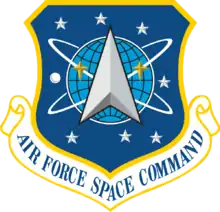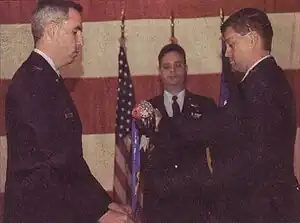1st Expeditionary Space Control Squadron
The United States Air Force's 1st Expeditionary Space Control Squadron is a provisional squadron attached to the 21st Space Wing at Peterson Air Force Base, Colorado.
1st Expeditionary Space Control Squadron
 | |
|---|---|
 The squadron guidon is furled during its inactivation ceremony, 9 June 2008 | |
| Active | 1989-2008 |
| Country | |
| Branch | |
| Role | Space Control |
| Part of | Air Force Space Command |
| Motto(s) | Vigilance Over Space |
| Decorations | Air Force Outstanding Unit Award[1] |
| Commanders | |
| Notable commanders | B. Chance Saltzman |
| Insignia | |
| 1st Expeditionary Space Control Squadron emblem (approved 15 November 1994)[1] |  |
Before conversion to provisional status, the 1st Space Control Squadron' was a space situational awareness unit last located at Vandenberg Air Force Base, California. The squadron commanded the United States Space Surveillance Network to detect, track, identify and catalog positional data for all man-made objects in Earth orbit. The squadron was established in 1989 as the 1st Command and Control Squadron at Cheyenne Mountain Air Force Base, Colorado. It was inactivated in 2008 and its personnel and equipment were integrated into the 614th Air and Space Operations Center.
History
Background
The roots of the squadron can be traced to 1961, when the Space Detection and Tracking System Center at opened at Ent Air Force Base, Colorado. The center brought together Air Force and Navy systems designed to track objects in space in all directions, not merely Soviet missiles launched over the North Pole. The center came under the operational control of North American Air Defense Command.[2] There were several subsequent moves, name changes, and changes in personnel, experience, and equipment.
Activation
The Air Force activated the 1st Command and Control Squadron at Cheyenne Mountain Air Force Station, Colorado in December 1989 to operate the system.[1] The 1st Command and Control Squadron provided collision avoidance support during each shuttle mission as well as maintaining an extensive satellite catalog (the "SATCAT" or "Box score").[3] This catalog is used by U.S. civilian and military agencies when launching new satellites into space, as well as by U.S. allies.[4]
The 1 SPCS tracked and compiled positional data on thousands of man-made objects in space partly to prevent collisions between newly launched satellites and other objects already orbiting the Earth. Additionally, the unit had the mission to task 30 space sensors within Space Surveillance Network to track satellites for US Strategic Command (USSTRATCOM) to maintain an accurate satellite catalog (SATCAT) of over 9000 objects orbiting the Earth.,[5][6] To support manned space flight, 1 SPCS constructs a theoretical box around the Space Shuttle, MIR or ISS, and projects flight path intersections for 36 to 72 hours. If any objects intersects the theoretical box, the unit forwarded the analysis to NASA, allowing them to determine whether to change the spacecraft/space station's flight path. Based on 1 SPCS mission analysis, and its predecessor units, NASA has moved the Space Shuttle 12 times and the International Space Station five times since 1981. [7] In June 1995, the unit tracked the U.S. Space Shuttle Atlantis during its historic rendezvous with the Russian space station Mir. The unit also compiled a catalog of space objects.[8][9]
The 1 SPCS also contained international personnel, such as Canadian military, since SSA was not just a U.S. problem.[6]
Move
In 2006, Admiral Timothy Keating, commander of NORAD directed a study on the continued use of the hardened command post at Cheyenne Mountain in view of what was perceived as diminished threats.[10] The decision to close Cheyenne Moungain required a unit move. The unit moved to Vandenberg Air Force Base, California in 2007 to better coordinate activities with the Joint Space Operations Center, it lost over 150 years of expert civilian experience.[11](archive returns only an error message)
Inactivation
The unit was inactivated on 9 Jun 2008, and its mission and members integrated into the 614th Air and Space Operations Center / Joint Space Operations Center.[12] Unconfirmed sources state that Cheyenne Mountain may retain some capability to cover the 1 SPCS mission, if required.[13] At the time of inactivation, 106
Lineage
- Constituted as the 1st Command and Control Squadron on 30 November 1989
- Activated on 1 December 1989
- Redesignated 1st Space Control Squadron on 1 October 2001
- Inactivated c. 9 June 2008
- Redesignated 1st Expeditionary Space Control Squadron and converted to provisional status on 11 February 2009
- Activated 27 February 2009[14]
Assignments
- 1st Space Wing, 1 December 1989
- 73d Space Surveillance Group (later 73d Space Group), 28 February 1992
- 721st Space Group, 24 June 1994
- 21st Operations Group, 26 April 1995 – c. 9 June 2008
- Air Force Space Command to activate or inactivate as needed, 11 February 2009
- Attached to 21st Space Wing, 27 February 2009[14]
Stations
- Cheyenne Mountain Air Force Base (later Cheyenne Mountain Air Station, Cheyenne Mountain Air Force Station), Colorado, 1 December 1989
- Vandenberg Air Force Base, California, 31 July 2007 - 9 June 2008
- Peterson Air Force Base, Colorado, 27 February 2009 – present[14]
Commanders
- Lt David Agee (1989–1991)
- Lt Col Joseph Wysocki (1991–1992)
- Lt Col John M. Rabins (1992–1994)
- Lt Col Michael A. Muolo (1994–1996)
- Lt Col Joseph G. Baillargeon (1996–1998)
- Lt Col David A. Strand (14 Aug 1998-2000)
- Lt Col Craigen B. Anderson (2000-2002)
- Lt. Col. Scott F. Shepherd (2002–2004)[15]
- Lt Col Michael Mason (circa 2007),[16]
- Lt Col Chance Saltzman (July 2007-2008)[12]
Awards
| Award streamer | Award | Dates | Notes |
|---|---|---|---|
| Air Force Outstanding Unit Award | 1 December 1989-31 August 1991 | 1st Command and Control Squadron[1] | |
| Air Force Outstanding Unit Award | 1 October 1995-30 September 1997 | 1st Command and Control Squadron[1] | |
| Air Force Outstanding Unit Award | 1 January 1998-31 December 1998 | 1st Command and Control Squadron[1] | |
| Air Force Outstanding Unit Award | 1 October 1997-30 September 1999 | 1st Command and Control Squadron[1] | |
| Air Force Outstanding Unit Award | 1 January 1999-31 December 1999 | 1st Command and Control Squadron[1] | |
| Air Force Outstanding Unit Award | 1 January 2000-31 August 2001 | 1st Command and Control Squadron[1] | |
| Air Force Outstanding Unit Award | 1 October 2004-30 September 2005 | 1st Space Control Squadron[17] | |
| Air Force Outstanding Unit Award | 1 October 2005-30 September 2006 | 1st Space Control Squadron[17] | |
| Air Force Outstanding Unit Award | 1 October 2006-30 July 2007 | 1st Space Control Squadron[17] | |
| Air Force Outstanding Unit Award | 31 July 2007-9 June 2008 | 1st Space Control Squadron[17] |
See also
References
- Notes
- Haulman, Daniel L. (April 15, 2008). "Factsheet 1 Space Control Squadron (AFSPC)". Air Force Historical Research Agency. Retrieved May 20, 2017.
- Sloan p. 98
- Wood, Douglas S. (August 2, 2005). "Cataloging space junk: Working on the 'world's largest jigsaw puzzle'". CNN. Retrieved May 29, 2017.
- "21st Space Wing [21 SW]". Globalsecurity.org. July 20, 2011. Retrieved May 29, 2017.
- Miller, James G. (Gil) (2007). "A New Sensor Allocation Algorithm for the Space Surveillance Network". MOR Journal Abstracts. Vol. 12, no. 1. Military Operations Research Society. Archived from the original on May 17, 2008. Retrieved April 16, 2009.
- Bridges, Holly (2007). "Space: the final recruiting frontier". The Maple Leaf. National Defence and the Canadian Forces. 10 (5). Archived from the original on February 14, 2012. Retrieved April 16, 2009.
- Staff writer(s) (June 10, 2003). "SGI Systems Help U.S. Air Force Space Command Detect, Track, Identify And Catalog Man-Made Objects in Space". Archived from the original on November 19, 2006. Retrieved May 20, 2017.
- Schmalz, Trisha (August 6, 2007). "NASA honors 1st Space Control Squadron team". Air Force Space Command Public Affairs. Archived from the original on April 26, 2009. Retrieved May 29, 2017.
- Kelso, T.S.; Morris, R.F.; DeVere, G.T.; Randolph, J.C.; Bowman, B.R.; Racca, R.A.; Thurston, N.L. "Space Surveillance Contributions to the STS 107 Accident Investigation" (PDF). Celestrak.com. Retrieved May 29, 2017.
- Zubeck, Pam (June 16, 2006). "Cheyenne Mountain's fate may lie in study contents". The Colorado Springs Gazette. Archived from the original on March 19, 2008. Retrieved May 20, 2017.
- "Space News: "Chilton: Progress Is Being Made On Space Situational Awareness," 24 Apr 2007". Archived from the original on May 13, 2009. Retrieved 2009-04-16.
- Stewart, SRA Erica (June 9, 2008). "1st Space Control Squadron inactivates, joins 14th AOC". 30th Space Wing Public Affairs. Archived from the original on March 3, 2016. Retrieved May 20, 2017.
- de Yoanna, Michelle (May 3, 2007). "Bad move? As NORAD leaves Cheyenne Mountain, some worry it's a dangerous mistake". Colorado Springs Independent. Archived from the original on June 11, 2011. Retrieved May 29, 2017.
- Robertson, Patsy (April 3, 2009). "Factsheet 1 Expeditionary Space Control Squadron (AFSPC)". Air Force Historical Research Agency. Retrieved May 20, 2017.
- "Peterson AFB Library Biographies: Col Scott F. Shepherd". 460 Space Wing Public Affairs. Archived from the original on February 14, 2012. Retrieved May 20, 2017.
- Scully, Janene (October 29, 2007). "Space unit settles in at VAFB". Santa Maria Times. Archived from the original on May 13, 2009. Retrieved May 17, 2017.
- "Air Force Personnel Services: Unit Awards". Air Force Personnel Center. Retrieved May 20, 2017. (search)
Bibliography
- Sloan, Elinor C. (2005). Security and Defence in the Terrorist Era. Quebec, Quebec, Canada: McGill-Queen's University Press. ISBN 9780773573208. Retrieved May 20, 2017. (link to Google Books Play)
External links
- 30th Space Wing: Vandenberg AFB home page
- "Space unit to move from Cheyenne Mountain". Air Force Link (AFPN). September 14, 2006. Archived from the original on June 18, 2007. Retrieved May 29, 2017.
- Staff reporter (September 14, 2006). "AF Space commander discusses future space capabilities". Air Force Link. Archived from the original on January 22, 2009. Retrieved April 16, 2009.
